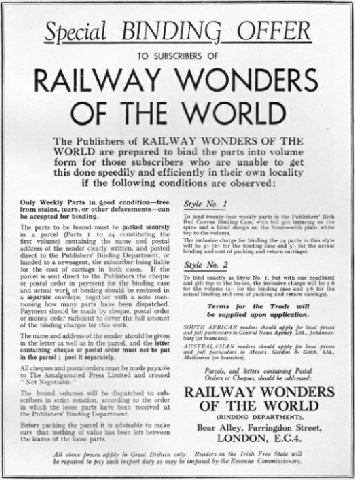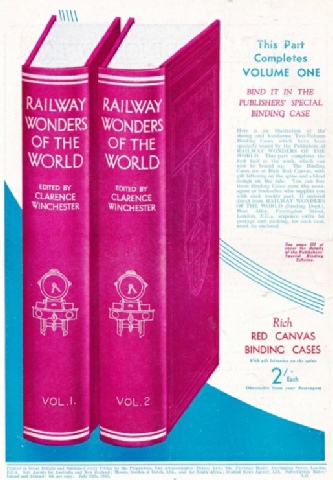
© Railway Wonders of the World 2012-


Editorial to Part 24


THIS is the time of the year when we think of holidays. To many railway enthusiasts the train journey is one of the most important parts of a holiday. There is a suggestion of romance in the sight of a great express waiting at the head of a holiday train. Some of the most famous trains in Great Britain carry the holiday crowds; among them is the famous “Cornish Riviera Express”.
Part 25 of Railway Wonders of the World, on sale next Friday, July 19, will contain a complete chapter on this famous train. The “Cornish Riviera Express” first ran in 1904, when it consisted of five light corridor coaches and a dining-
For many years the “Cornish Riviera Express” held the world’s record for the longest non-
I HAVE received many appreciative letters on the chapter on the railways of Germany and Holland which appeared in Parts 18 and 19. Next week I am devoting a further chapter to the latest railway developments in Germany. This will describe a remarkable rail-
Electricity has become a vital factor in modem rail transport. The great networks of suburban lines in the neighbourhoods of the world’s great cities are now nearly all electrically operated. Next week I shall include a chapter on the history of electric traction. The first experimental electric railway is said to have been invented by Thomas Davenport, a blacksmith, of Vermont, USA. In 1847, Professor Farmer was responsible for building an electric car carrying two passengers at Dover, New Hampshire. From that day many experiments were carried out in all parts of the globe, experiments in which rail and road cars were operated by means of electric storage batteries. But as we read in Part 19 of Railway Wonders of the World, the first successful electric railway in Great Britain was Volk’s, which we now regard as a pleasure line at Brighton. The development of electric traction is an outstanding example of how scientific progress on the railways has been made possible by the collective efforts of men working simultaneously all over the world. In this chapter, not only is the story of early electrical transport given, but also the fundamental principles that lie behind it. The chapter will be supplemented by some fascinating illustrations.
CONTINUING our popular series, “Railways of the Empire”, we shall include next week a chapter on the railways in Nigeria and Sierra Leone. There are nearly 2,000 miles of line open in Nigeria, and the systems are under the Nigerian Government. At one time there were two areas under separate administration, with two railway bases at Lagos and Port Harcourt. To-
OUR cover this week shows the “Lord Nelson”, which is one of the most powerful of the Southern Railway’s locomotives. It has four cylinders, of 16½-
FOR SPECIAL BINDING ANNOUNCEMENTS SEE BACK COVERS



